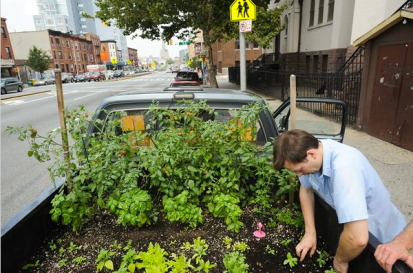Americans are building development projects over farmland. According to the American Farmland Trust and the 2007 National Resources Inventory, 4,1324,800 acres of rural land were converted between 1982 and 2007. As I stated in a previous post, a majority of healthy foods are grown in vulnerable areas for development. Therefore, sustainable land use is central to the healthy food revolution.
Urban populations are growing rapidly and many communities are at risk for low-access to fresh food. Conveniently, there is land that can be un-developed; in 2001, 15.4% of urban lands were vacant (Schless-Meier, 2013). Vacant lots often represent economic decline; they are desolate and unproductive. High concentrations of abandoned lots inhabit low-income communities, which must deal with the depreciated property values and crime that the vacant lots promote (Schless-Meier, 2013). The most logical, beneficial, and transformational thing to do with these properties: grow on them.
There are a number of ways to operate urban agriculture. Commercial farms are owned by a farmer that sells produce for profit. Institutional farms are operated by an organization or group ; produce can be sold or used for other collective farming purposes. Farmers can use Community Supported Agriculture (CSA), so that consumers can “subscribe” to their produce on a weekly basis. Community gardens are usually maintained by a group of people that grow the food to consume for themselves or give away. Sometimes community gardens are organized by a group that rent out plots for individual use.
The suitable location for these changes is near urban centers. Urban agriculture has a number of benefits to a community’s environment, social interactions, health, and economy. Urban farming adds important green space that is depleted from urban sprawl. It reduces carbon emissions by growing food nearby, opposed to the thousands of miles food travels now (Howard). Farms reduce water runoff, create shade, and reduce the heat island effect in cities (Howard).
Urban agriculture also positively impacts the health of cities. Adults who live with someone participating in a community garden were 3.5 times more likely to consume fruits and vegetables five times a day compared to someone who does not (Alaimo, Packnett, Miles, & Kruger, 2008). Urban farms often offer cooking and nutrition classes that teach urban dwellers how to cook the food that they grow (Design Trust for Public Space, 2012). Where there is proximity for fresh food and the opportunity to grow our own fruits and vegetables, it will improve our connection to healthy food.
Urban farms can also improve local economies. Food is delivered faster because it is traveling very few miles. Therefore, stores can restock more often and waste less food. There are more opportunities to buy directly from farmers or to grow your own food, so the selections are mark-up free. One can receive six dollars worth of vegetables for every one dollar invested in an urban garden (James, 2012). Also, in local markets there is a deeper awareness of the supply and demand, the cultural preferences, and behavior of the consumers (James, 2012). Most importantly, the income stays within the community instead of a multinational corporation. And this income goes toward healthy food, which will save everyone money from medical costs.
Urban agriculture utilizes all the strengths of a community: collaboration, hard work, utilizing existing resources, and social capital. As our agricultural land depletes, we must begin to create our own green and productive spaces for the betterment of our towns and cities. I will explore some urban farm movements and their impact on cities in my next post.



- All from National Geographic: Urban Farming Is Growing a Green Future
Alaimo, K., Packnett, E., Miles, R.A., & Kruger, D.J. (2008). Fruit and vegetable intake among urban community gardeners. Journal of Nutrition Education and Behavior, 40, 43-101. doi: 10.1016/j.jneb.2006.12.003.
Howard, B.C. Urban farming is growing a green future: Green Gotham. National Geographic. Retrieved from: http://environment.nationalgeographic.com/environment/photos/urban-farming/#/earth-day-urban-farming-new-york-rooftop_51631_600x450.jpg
James, Adam. (2012). How urban farming can transform our cities – And our agricultural system. Think Progress. Retrieved from: http://thinkprogress.org/climate/2012/05/29/491271/how-urban-farming-can-transform-our-cities-and-our-agricultural-system/
Metrics Framework. (2012). Design Trust for Public Space. Retrieved from: http://www.fiveboroughfarm.org/impact/
Schleiss-Meier, Adrien. (2013, July 26). K(no)w Vacancy: From NY to PA, urban land maps support reclaiming abandoned lots. Civil Eats. Retrieved from: http://civileats.com/2013/07/26/know-vacancy-from-new-york-to-philadelphia-urban-land-maps-support-communities-in-reclaiming-abandoned-lots/
What’s happening to our farmland?. American Farmland Trust. Retrieved from: http://www.farmland.org/resources/fote/default.asp
















